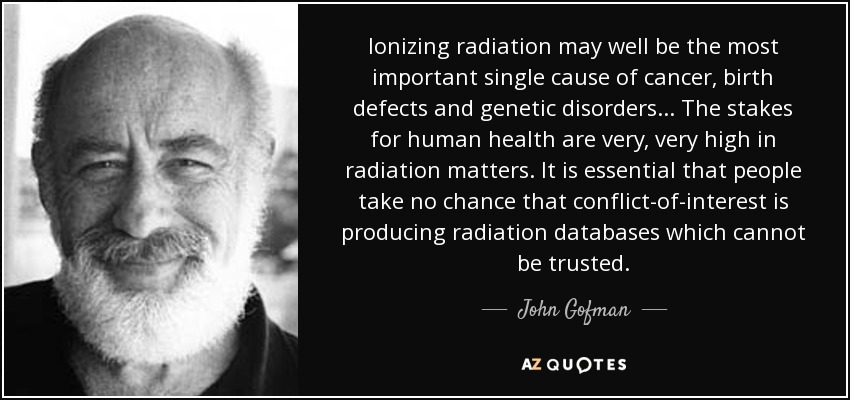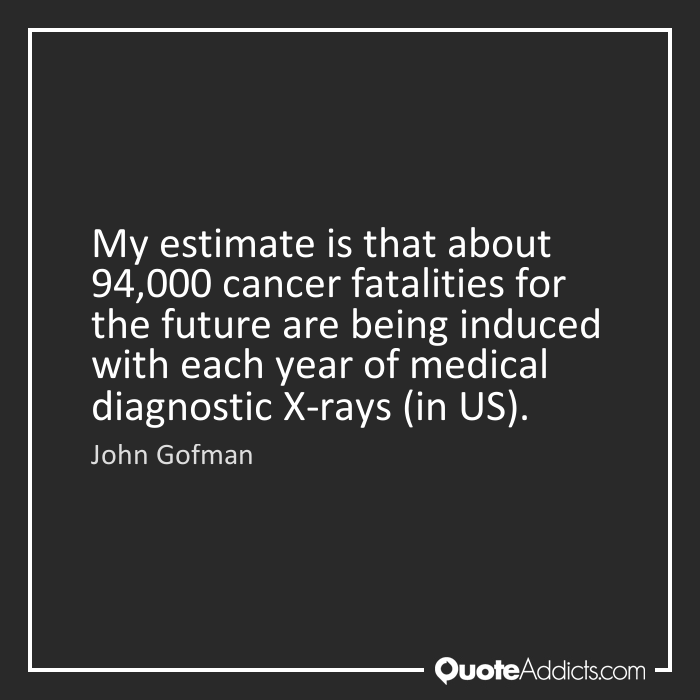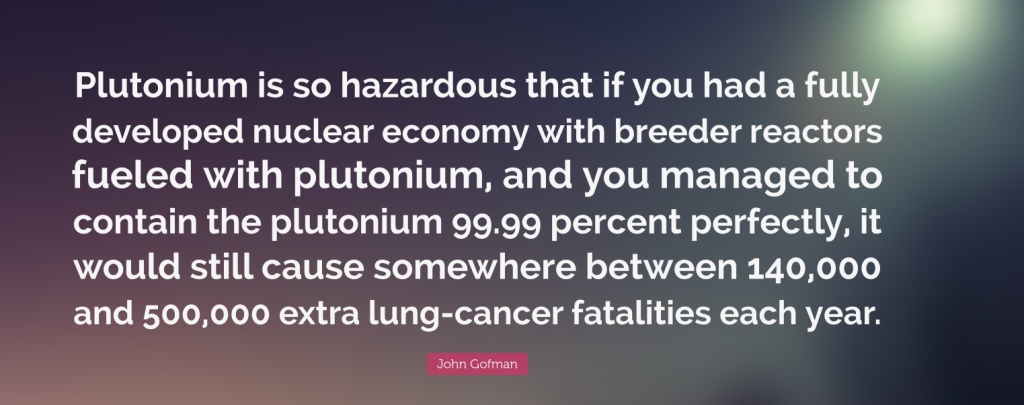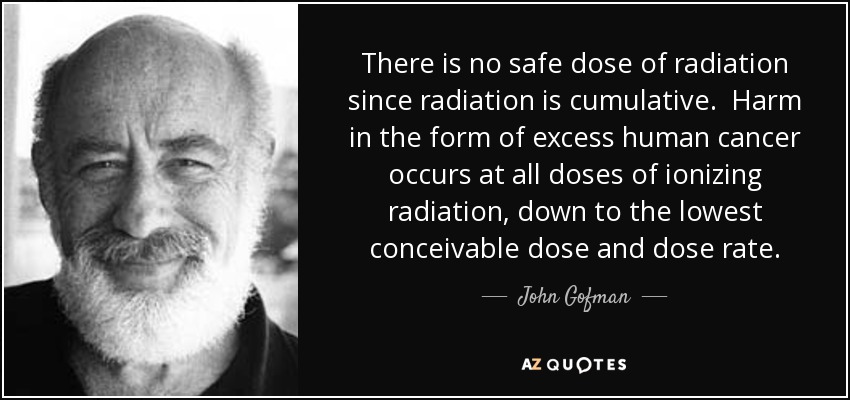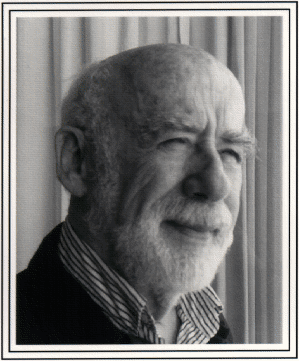
[back] Radiation
Dr John Gofman
[back] Radiation
"The Nuclear Industry is conducting a war against humanity."--Dr John Gofman
CV http://www.ratical.org/radiation/CNR/RMP/AboutAuthorF.html
[1994] Interview: Dr John Gofman
Radiation from Medical
Procedures in the Pathogenesis of Cancer and Ischemic Heart Disease:
Dose-Response Studies with Physicians per 100,000 Population, by John W. Gofman,
M.D., Ph. D., Edited by Egan O'Connor, (1999, 699 pages)
Hypothesis-1: Medical radiation is a highly important cause (probably the
principal cause) of cancer mortality in the United States during the Twentieth
Century. Medical radiation means, primarily, exposure by xrays (including
fluoroscopy and CT scans).
Hypothesis-2: Medical radiation, received even at very low and moderate doses,
is an important cause of death from Ischemic Heart Disease; the probable
mechanism is radiation-induction of mutations in the coronary arteries,
resulting in dysfunctional clones (mini-tumors) of smooth muscle cells.
See: Mammography Radiation Radiation therapy Depleted Uranium THE RADIATION STORY NO ONE WOULD TOUCH by Geoffrey Sea
Quotes
The human experimentation that has been done is bad, and it's
good that that's being cleared away. But for 25 years the DOE has not shown any
concern for the health of Americans. Their concern has been for the health of
the DOE. Their falsehoods concerning the hazards of ionizing radiation have put
not thousands of people at risk, not millions of people, but billions of people.
[1994] Interview
If the public should come to learn the truth about ionizing radiation, nuclear energy and the atomic energy program of DOE is going to be dead. Because the people of this country -- and other countries -- are not going to tolerate what it implies. The key thing -- it's everything in the DOE program -- is: "We must prove that low doses of radiation are not harmful." They have been conducting a Josef Goebels propaganda war, saying there's a safe dose when there has never been any valid evidence for a safe dose of radiation. Yet the DOE and others continue to talk about their "zero-risk model." [1994] Interview: Dr John Gofman
We can now say, there cannot be a safe dose of radiation. There is no safe threshold. If this truth is known, then any permitted radiation is a permit to commit murder. [1994] Interview: Dr John Gofman
By the way, medical radiation, from x-ray machines, is roughly twice as harmful per unit dose as Hiroshima-Nagasaki radiation. [1994] Interview: Dr John Gofman
I'm sad to say, I don't think 90% of doctors in this country know a goddamned thing about ionizing radiation and its effect. Somebody polled some pediatricians recently and said, "Do you believe there's a safe dose of radiation?" And 45% said, "Yes." They weren't asked, "What papers have you ever read on this subject that led you to conclude there's a safe dose?" I think medical education on the hazard of radiation is atrocious. What have they taught you in radiology? [1994] Interview: Dr John Gofman
If you ask me, "Do you stand against medical x-rays?" the answer is no. And
I've written a book with Egan O'Connor on the health effects of common exams. We
take the position: if there's a diagnostic gain for you -- something that can
really make a difference in your health and your life -- then don't forego the
x-ray. But there's another part of the picture. Up until recently -- it may be a
little better now than it was -- government studies show that most hospitals and
most offices of radiologists didn't have the foggiest notion of what dose they
were giving you for a procedure. Nor did they know that the procedure could be
accomplished with a third or a tenth of the dose. Joel Gray, a health physicist
at the Mayo Clinic, said there are places giving you 20 times the dose needed
for a given picture. And, he said, "If you ask those people and they can't
answer, you can be fairly confident that they're giving you a bigger dose than
necessary." So Egan and I, in The Health Effects of Common Exams, took
the data on what the average doses were in the United States, versus what has
been accomplished by some elegant work in Toronto to reduce the dose to
one-third of what was the average practice in 1984, and found that about 50,000
fatal cancers per year could be prevented. That' s a million and a half in a
generation! So what is this stuff about "Most procedures don't hurt you, they're
small?"
Let me say one more thing about the medical profession. It's my view
that we have a really crazy situation with respect to x-rays. You go to a
physician -- your internist, or a GP, or an obstetric gynecologist, or an
orthopedic surgeon -- these are the people who send you out for an x-ray. They
represent, or should, your ombudsperson. And they, not you, should have to find
out whether the facility they're sending you to uses five times the dose needed,
or a decent dose of radiation. But if you ask that so-called ombudsperson,
"Where you're sending me, do they know how to keep the dose down? What dose will
I get?" He'll mumble, "Don't worry about it, no problem." That's the fault of
medical education in our universities. If we turn out physicians who don't have
the attitude that they're the ombudsman for things like that, I think they're
not doing the job.
[1994] Interview: Dr John Gofman
The medical profession is implicated directly. I've spoken to Andre Bruewer, who practices in Tucson. He's a first-class radiologist who does nothing but mammography. And he said, "John, I shudder to think of what we were doing 20 years ago." We were touting mammography when the dose was four to five rads, and in some cases 10 rads. Now if you give enough women four to five rads, at something of the order of a 2 percent increase in breast-cancer rate per rad -- that's what my analyses show, and I've analyzed the world data on x-rays very carefully with respect to breast cancer in particular -- it has to be that women irradiated 15, 20 years ago got horrendous doses from mammography compared to now. And therefore, some of the present increase in breast cancer has to be from the radiation they got; but they don't like to talk about it. [1994] Interview: Dr John Gofman
There was a time, 20 to 30 years ago, when there were mobile x-ray units that
gave x-rays of the chest. They didn't give the 20 millirads [a 50th of a rad]
that is possible today. They gave about five rads. Children went through those
things by the thousands. And we just say, "We don't know why this cancer
epidemic is taking place now." Nobody's taken account of it. It's hard to know
how many children got it and who they were and follow them up. But you know that
a certain number of people are having cancers now as a result of what was done
15, 20 years ago.
Back in the '50s one woman brought a child in in the middle of the night
having real difficulty breathing, and a resident said, "Maybe the thymus gland
is enlarged and pressing on the trachea. Let's give this child 100 or 150 rads
of radiation in the neck." And as with many disorders, the child got better by
morning. And so this resident put two and two together and said, "I gave the
radiation, the child got better, therefore I cured him." And so this became the
rage and all kinds of hospitals were using radiation to treat an enlarged
thymus.
[1994] Interview: Dr John Gofman
There have been careful studies now of these kids that had the irradiation
for enlarged thymuses -- which, by the way, is no longer believed to have been a
disease that existed in the first place -- and they're having an excess of
thyroid cancers, an excess of salivary gland cancers. One hospital in Pittsburgh
said, "Why should we wait till these children come into the emergency room at
night with croup?" And they, for a period of over a year, gave x-rays to every
child leaving the nursery...
There is this wall that prevents us from relating past experience to the
occurrence of cancer. The full effects are not known. It's not just what the
average dose was back then, some places were giving horrendous doses. Sometimes
they'd get a picture that was too faint. So they'd take another one, with a
longer exposure -- when the problem was that their developing solution was
getting spent. And all they had to do was change the developer. But instead of
that they gave the person an extra x-ray with a bigger dose.
[1994] Interview: Dr John Gofman
If I were a member of the public, knowing what I know: if the establishment told me that something had a certain risk, I'd assume that the true risk was at least 10 times worse. Part of the problem comes from the patient. If a patient goes to a doctor -- especially if he's covered by a health plan -- and the doctor doesn't give him any procedures, they feel cheated. "You didn't even take an x-ray!" But the medical profession has to be regarded as culpable, along with the DOE. They both have the same conflict of interest: their work exposes people to radiation. For the DOE there have been all kinds of people of shady character in all kinds of government posts. But damn it, the medical profession shouldn't be shady and corrupt. I'd like to see them really apply the Hippocratic oath to this field. [1994] Interview: Dr John Gofman
Evgeny Chasov, who shared the Nobel Peace Prize with the International Physicians for the Prevention of Nuclear War, made a public statement that nobody has been harmed in the population at large. He obviously wasn't referring to the people who got killed immediately. There've been all kinds of statements to the that effect. Alla Yaroshinskaya, a journalist in Zhitomirsk, a small city in the Ukraine, became very suspicious of the sort of things that were being said. She found out that some of the people who were being moved had been moved to a place that was even hotter sometimes -- it was all just for show! Her paper wouldn't publish her investigation, and they told her she'd be in big trouble... But she persisted, and she got Izvestia to publish it, and she became well known. She got elected to the Supreme Soviet. And she demanded to see the protocols of government meetings on the Chernobyl situation. She managed to get all 40 protocols, and she wrote an article, which is now in book form in Russian and, there's a French edition: "The 40 Protocols of the Wise Men of the Kremlin." And it shows that at every one of their meetings, what they were saying internally was the exact opposite of what they were saying publicly... [1994] Interview: Dr John Gofman
In the '20s we had a radium-dial painting industry to paint the dials
of wristwatches and clocks. Women sat at tables with a little pot of radium
paint, painting these dials by hand. Their brushes would get diffuse and they'd
take the brush and twirl it in their mouths to get a fine tip to paint with. And
these women came up with the most horrible bone destruction due to the alpha
particles from radium in their bone. Osteogenic sarcomas. It was all written up
by 1929, by Harrison Martland, the coroner in New Jersey who examined their
bodies. The whole world knew that alpha particles from radium had done this to
humans. Now an alpha particle, really, doesn't ask who its mother or father was.
An alpha particle is an alpha particle. In Germany and Czechoslovakia there are
regions where it was long known that 50 to 75 percent of the miners died of what
was called "mountain sickness."
In the late 19th century
Hartung and Hesse discovered that this mountain disease was lung cancer. In the
1930s, Peller and another group determined that the reason for the lung cancer
in the miners was breathing radon with alpha particles from the uranium in the
mines. So alpha particles had been proven to produce cancer. So to say that the
effects of alpha particles from plutonium were unknown -- it's just not true.
The AEC, which approved of some of that experimentation, knew precisely what the
results would be. Merril Eisenbund, a pro-nuclear environmentalist, was working
for the AEC in 1947. He went out west to inspect what was going on in the
uranium mines in Arizona, New Mexico, and Colorado. He came back and wrote a
report saying the mines are not being ventilated, and if we don't get them
ventilated, we're going to have a lung-cancer epidemic worse than Germany and
Czechoslovakia. He was told to move over to another division, never to say
anything more about the mining situation in Colorado. The mine operators were
not informed, the mine workers were not informed, and we had the lung-cancer
epidemic that had been predicted. The AEC knew all this. Can you tell me there's
any evidence that the AEC, ERDA or DOE ever gave a damn about human health? They
were the same people who approved the human experimentation. And to try to
justify it in the name of the Cold War and things like that, that's ridiculous.
The Cold War did not require knowing where plutonium went in people's bodies!
[1994] Interview: Dr John Gofman
I'm not impressed by the integrity and forthrightness of the medical
establishment. I wouldn't have said this 10, 15 years ago, but today, when I
look at an article in a medical journal -- peer review means nothing to me,
that's just an old boys' club -- I say to myself, "Why should I believe this?"
I've watched stuff get in that was peer reviewed that was absolute rubbish, and
they had to know that it was absolute rubbish.
I just have lost my confidence in their integrity. A case in point. I
recently read a study that if you treat breast cancer by lumpectomy and
radiation, that's better than without the radiation. How carefully was that
study set up? Who oversaw the choice of people and the outcomes? It's a very
important issue. If you irradiate the chest of women who've had lumpectomies,
with the kind of doses they're giving, you will produce a lot of cancers in the
future. Not necessarily the cancer they had, but you're going to produce new
cancers. Those new cancers are going to come 10, 15 years from now. If indeed
the radiation prevents [patients] from dying of the original cancer, which would
have killed them in a year or two, then I say, with their fully informed
knowledge, they may choose to take the radiation therapy. But I really want to
be sure that the data collected on this benefit is right. So my answer to your
question is: I hope it's better; I think it's better than it was; I would
like to see better mechanisms still, that didn't involve grants and the prestige
of the university when the university passes on whether research is okay.
[1994] Interview: Dr John Gofman
There's an investigator named Holm at a Swedish hospital. They've done 38,000 radioiodine scans to test thyroid function. He wrote a series of papers showing that even though people got 50 rads to the thyroid, there was no excess of thyroid cancer. When I first heard about it I thought, "Wow, you can give 50 rads to the thyroid and cause no cancers? Does it mean I'm wrong?" And this was trumpeted an over the United Nations Atomic Effects Committee and everybody in the establishment cites it. Well, I analyzed those papers -- I devoted a chapter to it in my 1990 book (Radiation-Induced Cancer from Low-Dose Exposure). And you know what I this guy did? He threw 135 cancers out of the study, because they occured before five years had elapsed. He said, "We know they can't occur before five years." The evidence in Byelorus is that they're coming in four, five, six years after the exposure. If you take the 135 cases and add them back, you've got a big effect from radioiodine. That's what's being said about radioiodine: not to worry, no problem. [1994] Interview: Dr John Gofman
"Licensing a nuclear power plant is in my view, licensing random premeditated murder. First of all, when you license a plant, you know what you're doing--so it's premeditated. You can't say, "I didn't know." Second, the evidence on radiation-producing cancer is beyond doubt. I've worked fifteen years on it [as of 1982], and so have many others. It is not a question any more: radiation produces cancer, and the evidence is good all the way down to the lowest doses."---Dr John Gofman (Nuclear Witnesses, Insiders Speak Out, by Leslie J. Freeman)
"Many people think nuclear power is so complicated it requires discussion at a high level of technicality. That's pure nonsense. Because the issue is simple and straightforward. There are only two things about nuclear power that you need to know. One, why do you want nuclear power? So you can boil water. That's all it does. It boils water. And any way of boiling water will give you steam to turn turbines. That's the useful part. The other thing to know is, it creates a mountain of radioactivity, and I mean a mountain: astronomical quantities of strontium-90 and cesium-137 and plutonium--toxic substances that will last--strontium-90 and cesium for 300 to 600 years, plutonium for 250,000 to 500,000 years--and still be deadly toxic. And the whole thing about nuclear power is this simple: can you or can't you keep it all contained? If you can't, then you're creating a human disaster."---Dr John Gofman (Nuclear Witnesses, Insiders Speak Out, by Leslie J. Freeman)
"My view is, there exists a group of people in the world that have a disease. I call it the "power disease." They want to rule and control other people. They are a more important plague than cancer, pneumonia, bubonic plague, tuberculosis, and heart disease put together. They can only think how to obliterate, control, and use each other. They use people as nothing more than instruments to cast aside when they don't need them any more. There are fifty million people a year being consumed in a nutritional holocaust around the world; nobody gives a damn about starvation. If fifty million white Westerners were dying, affluent Western society would worry, but as long as it's fifty million Third World people dying every year, it doesn't matter...............The structure we have now is, the sicker you are socially, the more likely it is that you'll come out at the top of the heap."---Dr John Gofman (Nuclear Witnesses, Insiders Speak Out, by Leslie J. Freeman)
In 1961, Dr. Ian MacKenzie, a physician in Nova Scotia, examined
a patient with rapidly-growing breast cancer. He noticed that the skin on her
chest showed signs of radiation burns. She explained that she had had
tuberculosis and that, as part of her treatment, she had had "artificial
pneumothorax therapy" (one of her lungs was intentionally collapsed); this
therapy included about 200 fluoroscopic x-rays of her lungs. (A standard x-ray
makes an snapshot image on photographic film; in fluoroscopy, examination of a
patient takes place while the x-ray beam stays turned on so the physician can
observe what happens when the patient, or the patient's organs, are in motion.
Fluoroscopes deliver a much larger dose of radiation than normal x-ray
snapshots.)
Dr. MacKenzie then studied 800 women who had been treated for
tuberculosis in one hospital between 1940 and 1949. He found that women who had
not had "artificial pneumothorax therapy" had a 1-in-510 chance of getting
breast cancer; women who had had the therapy had a one-in-21 chance of getting
breast cancer. In other words, women who had had many fluoroscopic exams of
their lungs had 24 times as great a chance of getting breast cancer as women who
had avoided fluoroscopy.
MacKenzie's work caused quite a "stir" in the radiation
community. Happily, it stimulated a Japanese researcher, C. K. Wanebo, to
examine the data gathered from the atomic bombings of Hiroshima and Nagasaki in
Japan in 1945. In 1968, Wanebo reported that radiation exposure at Hiroshima and
Nagasaki had caused a demonstrable increase in breast cancers among surviving
women. PREVENTING BREAST CANCER
